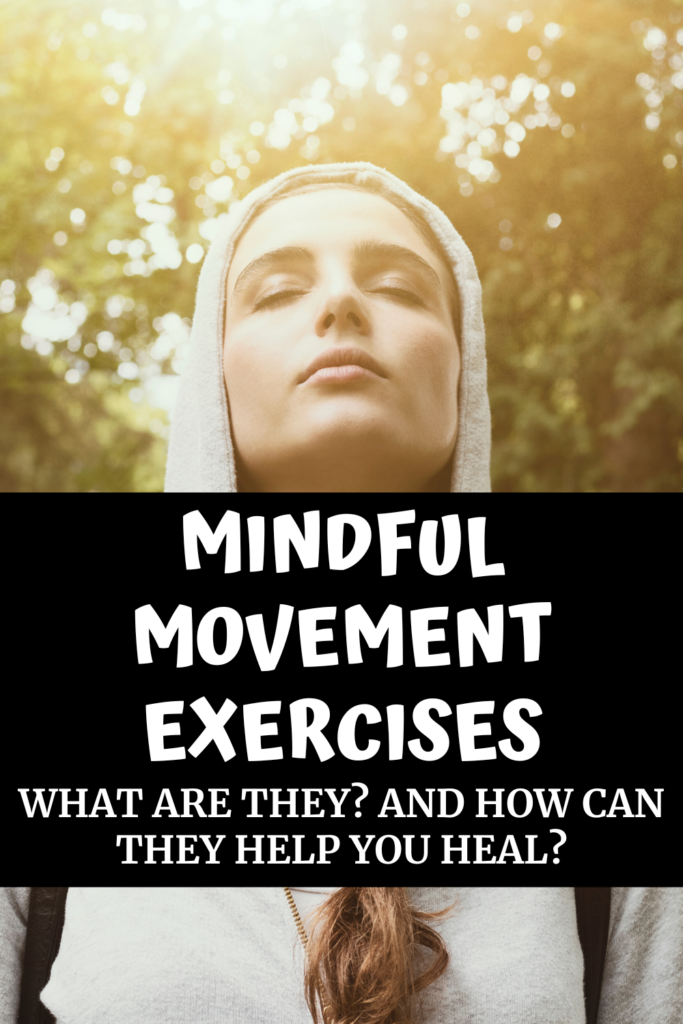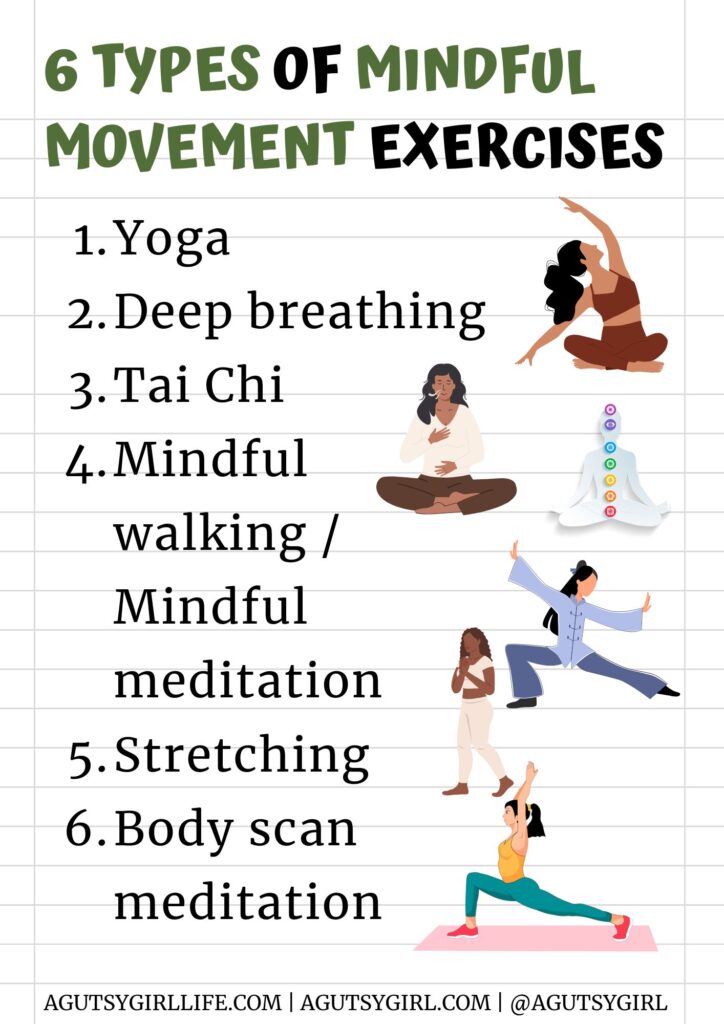Are you interested in exploring mindful movement exercises?
This week I began Week 2: Movement via the Chopra Ayurvedic Health Certification Program through the Institute for Integrative Nutrition.
Now that I’m over 40, my workouts look much different than they did in the past.
That being said, I’m constantly wanting to explore how to maximize movement (and flexibility!) for optimal health.
The course opened this week with this powerful statement + information:
While rest was once considered a luxury, the tables have turned. A sedentary lifestyle is now the norm, with less than 5% of adults participating in even just 30 minutes of physical activity per day. Today, the average person spends less time moving their body than at any point in human history. Over the past century or so, exercise has become the luxury. It’s hard to find time in our busy schedules to participate in physical activity, and gym memberships come at a premium.
Exercise
If you’ve been following along with A Gutsy Girl for any length of time, you know that I believe exercise is a great way to all the things:
- Help prevent disease
- A way to move through negative emotions
- Find more and enhanced creativity (my walks around the lake are prime for this!)
- Keep weight in check
- Age gracefully
But a new way I discovered framing all of this during the week 2 material is to start becoming more present through exercise.
Constantly moving, through whatever means, is different than being mindful about the exercise we’re performing.
Mindful Movement Exercises
Click HERE to save this article on Mindful Movement Exercises for later.

So what exactly is mindful movement anyways?
First, it’s paying attention the physical and emotional sensations in your body.
Instead of seeing exercise as lift heavy weights or get your heart rate up, view it as a great place to start from a holistic viewpoint; mind, body, soul.
This could include things like:
- Paying attention to the sounds – is your choice of music energizing or calming?
- Grasping touch – how does your body feel? What is the temperature in the environment? Is your posture correct?
- Sight – what surrounds you?
- Taste – have you appropriately fueled for your preferred exercise? Ideally with a six-taste meal.
- Smell – is there anything that is distracting your sense of smell?
If I think back to some of the workouts I enjoyed least, I can identify points from above that have made them feel that way. Can you?
Yoga
They say that yoga is Ayurveda’s sister science.
The two have been taught hand-in-hand for over 5,000 years.
It is a mind, body, and spirit practice that combines physical movement with mindful breathing.
According to the Chopra Ayurvedic Health Certification Program,
Yoga is a large body of practices ranging from moral, behavioral, and spiritual guidance to physical exercise and breathing techniques. The most familiar form is Hatha Yoga.
Other common forms of yoga include:
- Bikram
- Vinyasa
- Yin
- Power
- Ashanga Vinyasa
- Kundalini
4 Reasons for Yoga
- Yoga counters stress levels and anxiety. It is an effective way to improve mood through the regulation of neurotransmitters.
- Get to know yourself. While the mind wanders, yoga teaches us to be present and have a centered awareness. We are able to feel more in tune with our entire body and strengthen interoception – the communication between body and mind.
- Increase strength and energy. Yoga is a simple way to improve emergency levels, flexibility and balance. It focuses on both small and large muscle groups (you might not otherwise use) to help with strength and energy for daily life.
- Better digestion. Yoga modulates the enteric nervous system that independently regulates the digestive system.
Yoga and Seven Chakras
You can’t escape the yoga conversation as it relates to a top mindful exercise without highlighting the seven chakras.
They are, in fact, the foundation for many yoga practices.
I have been learning and studying them for a very long time.
Kimberly Lucas and I discussed them on the podcast episode, “How to Deal with Overwhelming Emotions.”
And, in case you didn’t know this about me, Sedona, AZ is one of my favorite places on planet Earth. I’ve been going to the sacred place since 2012, and during my travels there, I always learn something new about the chakras.
Anyways, chakras start at the base of your spine and move up to the (crown) top of your head.
According to the Chopra Ayurvedic Health Certification Program,
The lower chakras are related to Earthly matters such as survival, sex, and power. The top three chakras are related to higher consciousness, truth, intuition, and purpose. In the middle, the heart chakra bridges the two worlds with empathy, love, and compassion.
But what does yoga have to do with the chakras?
Well, once we understanding the elemental qualities of the chakras and the yoga asanas that open them up, you can cultivate a dosha-balancing yoga practice.
For example, if you start at the base – the root chakra (or Muladhara) – and desire to open this chakra up, you can do different yoga poses to directly affect it.
Poses like:
- Padmasana (lotus flexion)
- Tadasana (mountain pose)
- Janu sirsansana (head-to-knee)
- Malasana (squatting pose)
When this chakra is open, you’ll feel grounded, safe, and fearless.
In the full Chopra course, you’ll get a list of what each of these mindful movement practices look like for each chakra.
Join the Chopra Ayurvedic Health Certification Program
Remember: you can save 25% off the program simply by using code AGUTSYGIRL at checkout
BTW – the Chopra program also details how to use yoga and paying full attention for your dosha type.
Mine (for Vata) was spot on.
Breathing Techniques
The first time I ever started connecting the dots between breathing techniques and healing my gut was when I found myself in so much bloat and discomfort, laying on my bed and crying.
The bloating had gotten so bad that I could not zip my pants, and it would all lead to massive anxiety and a lack of breath.
In fact, it scared me so much to the point where I started researching breath and breathing to help calm me down when those body sensations became too much.
One of my favorite resources on this website to help you get started today is, IBS Breathing Exercises.
But here is more information if you want to go beyond that today.
Breathing IS Our Life Force
According to the Chopra Ayurvedic Health Certification Program,
Pranayama (the action of expanding the life-force energy in our bodies through intentional breathing) is a practice in yoga that focuses on the movement of the breath and its effects on our physiology. Like your heart rate, blood pressure, and digestion, breathing is an autonomic process—meaning you don’t have to think about it for it to work. Throughout your life, you’ll take around half a billion breaths without even realizing it.
Pranayama is the mind-body connection.
What I love about breathing as part of mindful practices is that you can do it anytime, anywhere, and without any exertion to see significant improvements in your overall health.
Some forms of deep breathing that are covered in the course include:
- Coherence breathing
- Ujjayi – simultaneously relaxing and energizing the mind and body
- Bhastrika
By the way, if you want to learn about the ins-and-outs of breathing through a scientific lens, you must read, Breath: The New Science of a Lost Art, by james Nestor.
4 Other Types of Mindful Movement
There are so many other ways to incorporate deliberate movements into your daily routine.

Here are 4 to consider:
Tai Chi
The practice of Tai Chi originated in ancient China. They say it’s one of the most effective exercises for health of mind and body
It is a moving meditation with the ultimate purpose to cultivate our inner life energy (qi).
This is a spiritual experience, as much as a physical one.
The movements are fluid, graceful, circular and slow. Breathing is deep, aiding visual and mental concentration.
You can learn much more about Tai Chi HERE.
Mindful Walking / Mindful Meditation
According to Positive Psychology there is no specific definition for mindful walking.
However they do make note about these points as they relate to mindful walking:
- Paying attention to the sensations of the body as you walk. How do your feet feel? How do the other muscles of your body compensate for changes in balance? Become more aware of your surroundings, not just practically, but with an open mind, enjoying the immediacy of the sights, sounds, and smells. Open up your senses.
- Mindful walking benefits from its simplicity and is most successful when you are in the moment.
Mindful walking is an easy way activity into any mindful movement program.
Stretching
Stretching might be one of the most important parts of my own simple mindfulness exercises that I fail to do, given how much I strength train.
As it relates to mindful movement, it is a powerful act because it can help with relaxation and stress management.
Stretching also helps the mind focus and become more aware in the present moment.
Both static (holding a position) and dynamic (controlled movements) stretching are excellent ways to keep your body free flowing and free from injury.
Body Scan Meditation
If your body feels good, bad or indifferent, but you haven’t taken a moment for acknowledging it — body scan meditation can help.
This is a meditation for people of ages and physical capabilities.
You lay on the floor in a horizontal position and just let your body feel.
Whatever it’s feeling, allow it – no judgements attached.
HERE is a great 30-minute body scan for beginners.
Letting go gives us freedom, and freedom is the only condition for happiness. If, in our heart, we still cling to anything—anger, anxiety, or possessions—we cannot be free.” Thich Nhat Hanh
Mindful Movement Exercises Improve Quality of Life
To know me personally is to know that I love getting in a good weight lifting session.
In fact, I documented exactly how I workout now that I’m in my 40’s.
Slowing down to focus on things like mindfulness meditation, mindfulness activities; yoga and the like do not come naturally to me.
But it makes perfect sense as I’m Vata type.
Like everything else in life, those things which we resist the most are typically the things we need.
I know that if I would start any of these practices on a daily basis, my life would improve; sleep quality, emotional state, a stronger connection to self and others + learning to be in the present vs. always thinking into the future.
Just taking some deep breaths while studying this through the Chopra course has given me a greater awareness. I feel like I’m now excited to put the pieces of mindful movement exercises (that are conducive for Vata) into practice.
Maybe you’re ready to join, too?
Remember: you will save 25% off the course simply by using code AGUTSYGIRL at checkout.
The Full Ayurvedic Series
This article is part of my full Ayurvedic series.
In addition to the hundreds of articles and thousands of hours I’ve spent in the last decade devoted to all things gut health and gut healing, I am working on becoming a certified Ayurvedic practitioner, so that I am able to give my clients the best, most comprehensive guidance for healing – 100% on an personalized level.
If you’re interested in working 1-on-1 with me, you can sign up HERE today.
And here are all the previous articles on Ayurveda you can binge-read now:
- What is Ayurveda – [The Ultimate Beginner’s Guide]
- Ayurveda for Balance
- Ayurvedic Food List
- Kitchari Cleanse Recipe [One Pot Kitchari]
Xox,
SKH
🤰 bloating be gone! weight loss through optimal gut health for women
💃ʜᴇᴀʟ ʏᴏᴜʀ ɢᴜᴛ. ʜᴇᴀʟ ʏᴏᴜʀ ʟɪfe.
🫶🏻 founder gutbyome.com





![Elimination Diet Food List [Phase 1]](https://agutsygirl.com/wp-content/uploads/2020/08/green-elimination-diet-featured-agutsygirl.com_.png)

